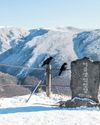
When big history is self-evidently being written, and leaders face momentous choices, the urge to find inspiration in instructive historical parallels is overwhelming and natural. "The only clue to what man can do is what man has done," the Oxford historian RG Collingwood once wrote. One of the contemporary politicians most influenced by the past is the Estonian prime minister, Kaja Kallas, and not just because of her country's occupation by Russia or her personal family history of exile.
Kallas lugs books on Nato-Russian relations, such as Not One Inch, with her on beach holidays. And in her hi-tech office at the top of the old town in Tallinn, she argued this was a 1938 moment - a moment when a wider war was imminent but the west had not yet joined the dots.
She said the same mistake was made in 1938 when tensions in Abyssinia, Japan and Germany were treated as isolated events. The proximate causes of the current conflicts in Ukraine, the Middle East, the South China Sea and even Armenia might be different, but the bigger picture showed an interconnected battlefield in which post-cold war certainties had given way to "great-power competition" in which authoritarian leaders were testing the boundaries of their empires. The lesson - and necessity - was to resist and rearm. "The lesson from 1938 and 1939 is that if aggression pays off somewhere, it serves as an invitation to use it elsewhere," Kallas said.
Her favourite historian, Prof Tim Snyder, adds a twist by reimagining 1938 as a year in which Czechoslovakia, like Ukraine in 2022, had chosen to fight: "So you had in Czechoslovakia, like Ukraine, an imperfect democracy. It's the farthest democracy in eastern Europe. It has various problems, but when threatened by a larger neighbour, it chooses to resist. In that world, where Czechoslovakia resists, there's no second world war."
This story is from the {{IssueName}} edition of {{MagazineName}}.
Start your 7-day Magzter GOLD free trial to access thousands of curated premium stories, and 9,000+ magazines and newspapers.
Already a subscriber ? Sign In
This story is from the {{IssueName}} edition of {{MagazineName}}.
Start your 7-day Magzter GOLD free trial to access thousands of curated premium stories, and 9,000+ magazines and newspapers.
Already a subscriber? Sign In

Bring it on home Led Zep's first biopic
How were the famously interview-shy rock gods persuaded to take part in a film about their early success with the band telling their own story?

Dead souls
The Nobel laureate bears witness to Korea's traumatic past as one woman's quest is told through haunting, harrowing imagery
Object lesson
An expat couple curate their lives by plants anc Radiohead LPs in this deliciously pessimistic chronicle of Berlin life

Legacy of violence
A seething and erudite-but flawedindictment of the west's role in the creation of Israel and everything that has flowed from it

The right are wrong on climate-why is the UK following their lead?
If you care about the world we are handing on to future generations, the news last Thursday morning was dramatic.

Power pointe
Ballet has always been more than just a job for Carlos Acosta. And as director of Birmingham Royal Ballet, he is trying to make it bigger than ever
Borders can't contain the devastating, destabilising crisis engulfing Sudan
As Sudan approaches its third year of civil war, the dynamics are shifting.

Heroes to villains
With 13 Oscar nominations, Emilia Pérez's cast and crew should have been flying high. Then came a social media scandal and a fearsome backlash

Bukele's rise Strongman who became the darling of the right
Five hours after being shot in the belly, a Haitian accountant sat in a Port-au-Prince emergency room pondering how his homeland might be saved.

Trump is fuelling lethal fantasies of driving people from their land
The shock and awe continues and it only gets more shocking and more awful.